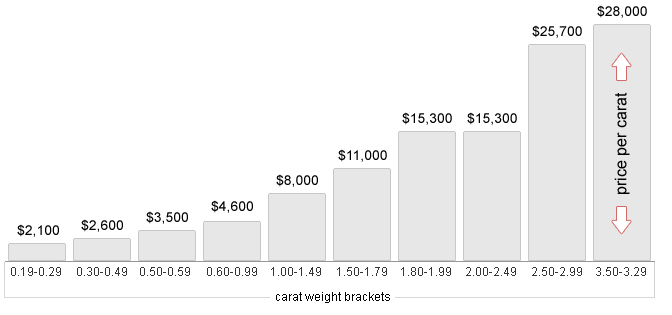Contrary to popular belief, carat weight is not an accurate reflection of a diamond’s size, the carat size.
A diamond increases in weight much faster than it increases in diameter. While small round diamonds that have the same carat weight are almost indistinguishable in size, the heavier a diamond gets, the less predictable its size is.
In order to determine a diamond’s size, the carat weight of the stone should be weighed in conjunction with the diamond’s diameter in millimeters and the diamond’s cut grade. The diamond’s diameter measured in millimeters reflects the appearance of the diamond as seen from above once the stone is mounted. It is measured across the girdle of the stone, and does not incorporate the height of the pavilion.
Some low carat diamonds with high grade cuts look larger than high carat diamonds with low grade cuts. Diamonds with higher cut grades reflect the maximum amount of light and generate the greatest fire and brilliance. This bright sparkle and intense luminescence can frequently cause the diamond to appear larger than it is, to create the impression of a large diamond carat size. Moreover, diamonds with lower cut grades can have long and deep pavilions that cause light to “leak out”, dulling and muting the stone’s radiance. These long pavilions may add weight to a diamond, but this weight is covered beneath the setting once the stone is mounted, making the diamond carat size appear much smaller. Viewers of diamonds such as these may be surprised by how small the stones appear in comparison to their carat weight.
Rough sizes for a round diamond can be seen below:

For other shapes, you may find the Diamond Database a good resource.
How carat weight affects diamond prices
Diamond prices rise drastically with increase in carat weight. This is because only one in approximately one million diamonds mined produces a full cut and polished one carat diamond. During the cutting process, a great deal of rough diamond material is lost; up to 40-60 percent of rough diamond is shed. The larger diamond, the rarer the diamond, the more expensive.
A regression analysis of available diamonds shows carat weight accounts for the biggest portion of the diamond value, followed by color and clarity. Still, a poorly crafted large diamond can be worthless compared to a much smaller, well-crafted stone.
Diamond prices typically increase at a higher rate from one weight / price bracket to the next. For example, price per carat for diamonds in the size bracket 1.00–1.49 carats could be $8,000, while price per carat in the bracket 1.49–1.99 carats can jump to $11,000.
In a graph below you can see how fast the price per carat jumps with diamond weight moving from one carat weight bracket to another.

To maximize the size of the purchased diamond without having to pay a higher price per carat, it is therefore better to buy diamonds with the size towards the higher end of a chosen price bracket:
For example, buy a diamond the size of 1.48, rather than 1.51 because the size of these stones would most likely be priced according to different price brackets. Thus, 1.48 carat diamond would be priced at 1.48 x $8,000 = $11,840 while 1.51 carat diamond would be priced at $11,000 per carat and thus would have the value of 1.51 x $11,000 = $16,600, that is $5,000 more for just 0.02 additional carats.
What is Total Carat Weight?
Total carat weight (ctw) refers to the total weight of all diamonds set in the jewelry item. For example, in order to calculate the TCW of a three stone ring, one would take into consideration the center diamond as well as the two side stones.
What Carat Weight Should I Choose?
Every diamond wearer has different criteria regarding their diamond, popular carat sizes vary greatly. Some value diamond carat size over clarity, others value color over carat weight. At Zoara we believe that the most important things to consider are personal taste, budget, and for a diamond ring, the setting and size of the finger or hand of the wearer.
- Personal Taste: Decide which of the Four Cs is the most important to you. Some are sensitive to brilliance and sparkle more than size. Others prefer large vintage-style diamonds which are typically less radiant, but greater in carat size.
- Budget: If you are looking for a larger stone but you’re on a budget, you can try to maximize the appearance of the stone by investing in the stone’s cut and choosing a brilliant shape. You may instead prefer to invest in a stone of high carat weight but with lower clarity, color and cut grades. Choosing a large diamond carat size over a large carat weight
- Setting: Diamonds that are longer in shape such as a marquis, pear, or rectangular emerald, can create the illusion of a larger diamond. Also, if a diamond is mounted into a high-pronged setting such as the tiffany setting or the tall prong setting, it can make a stone look larger. Finally, adding side accent stones of low carat and lower quality can be an affordable way to enlarge the ring and total carat weight.
- Finger Size: Small diamonds appear larger on small hands and vice-versa. Large diamonds can look clumsy on small or slender fingers. For a woman with small and thin fingers, you may want to consider a diamond of lower carat weight and a lower carat size.
